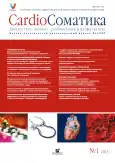The clinical and economic efficiency of treatment in patients with chronic heart failure
- Authors: Tarlovskaya E.I1, Malchikova S.V1
-
Affiliations:
- Kirov State Medical Academy, Ministry of Health of the Russian Federation
- Issue: Vol 4, No 1 (2013)
- Pages: 72-76
- Section: Articles
- URL: https://journals.rcsi.science/2221-7185/article/view/45055
- DOI: https://doi.org/10.26442/CS45055
- ID: 45055
Cite item
Full Text
Abstract
Full Text
##article.viewOnOriginalSite##About the authors
E. I Tarlovskaya
Kirov State Medical Academy, Ministry of Health of the Russian Federation
Email: etarlovskaya@mail.ru
д-р мед. наук, проф. каф. госпитальной терапии Кировской ГМА
S. V Malchikova
Kirov State Medical Academy, Ministry of Health of the Russian Federation
Email: malchikova@list.ru
д-р мед. наук, доц. каф. госпитальной терапии Кировской ГМА
References
- Mosterd A, Hoes A.W. Clinical epidemiology of heart failure. Heart 2007; 93: 1137–46.
- Агеев Ф.Т., Даниелян М.О., Мареев В.Ю. и др. Больные с хронической сердечной недостаточностью в российской амбулаторной практике: особенности контингента, диагностики и лечения. (По материалам исследования ЭПОХА–О–ХСН). Сердечная недостаточность. 2004; 1: 4–7.
- Гуревич М.А. Хроническая сердечная недостаточность: руководство для врачей. 5-е изд. М.: Практическая медицина, 2008.
- Якушин С.С., Смирнова Е.А. Могут ли эпидемиологические исследования в России улучшить диагностику и лечение сердечно - сосудистых заболеваний? Профилактика заболеваний и укрепление здоровья. 2007; 5: 20–1.
- Tendera M. Epidemiology, treatment, and guidelines for the treatment of heart failure in Europe. Eur Heart J 2005; 7 (Suppl. J.): 5–9.
- Беленков Ю.Н., Мареев В.Ю., Агеев Ф.Т. Эпидемиологические исследования сердечной недостаточности: состояние вопроса. Cons. Med. 2002; 4 (3): 5–7.
- Jhund P.S., Macintyre K, Simpson C.R. et al. Long - term trends in first hospitalization for heart failure and subsequent survival between 1986 and 2003: a population study of 5.1 million people. Circulation 2009; 119: 515–23.
- Национальные рекомендации по диагностике и лечению хронической сердечной недостаточности. Сердечная недостаточность. 2010; 11 (1).
- Swedberg K, Komajda M, Bohm M. et al. Ivabradine and outcomes in chronic heart failure (SHIFT): a randomised placebo - controlled study. Lancet 2010; 376 (9744): 847–9.
- Отраслевой стандарт «Клинико - экономические исследования. Общие положения» 91500.14.0001–2002.
- http://www.minzdravsoc.ru
- http://www.aptechka.ru
- http://www.rosminzdrav.ru
- Воробьев П.А., Авксентьева М.В., Вялков А.И. и др. Клинико - экономический анализ. М.: Ньюдиамед, 2008. 15.
- http://publications.nice.org.uk/ivabradine-for-treating-chronic-heart-failure-ta267
- Соколов И.М., Карабалиева С.К. Структура амбулаторной медикаментозной терапии больных с хронической сердечной недостаточностью после перенесенного инфаркта миокарда. Современные проблемы науки и образования. 2007; 1: 116–20.
- Россия` 2012: Стат. справочник. М., 2012.
- Ягудина Р.И. Методология проведения анализа «затраты–полезность» при проведении фармакоэкономических исследований. Фармакоэкономика. 2012; 2: 9–12.
Supplementary files







